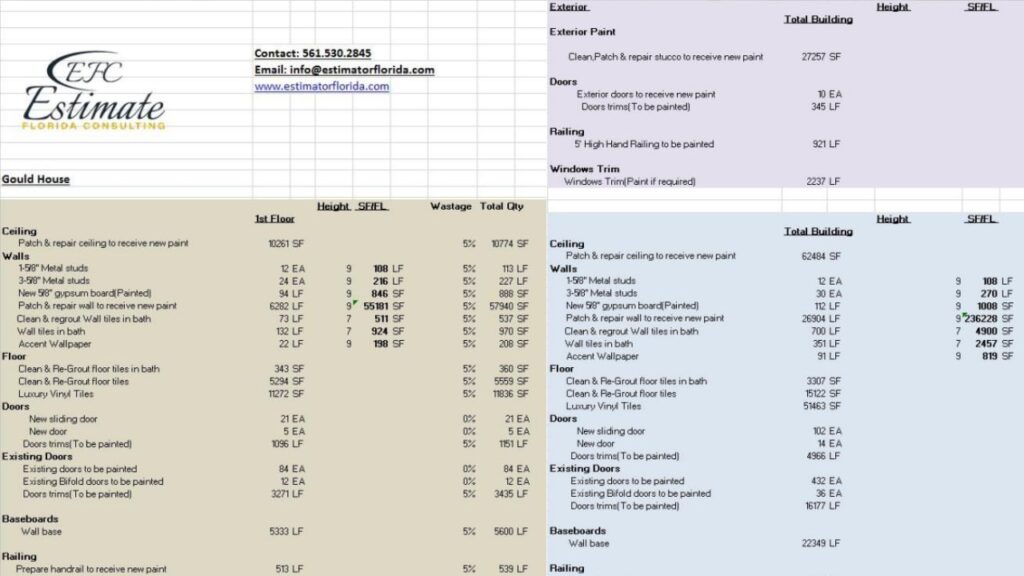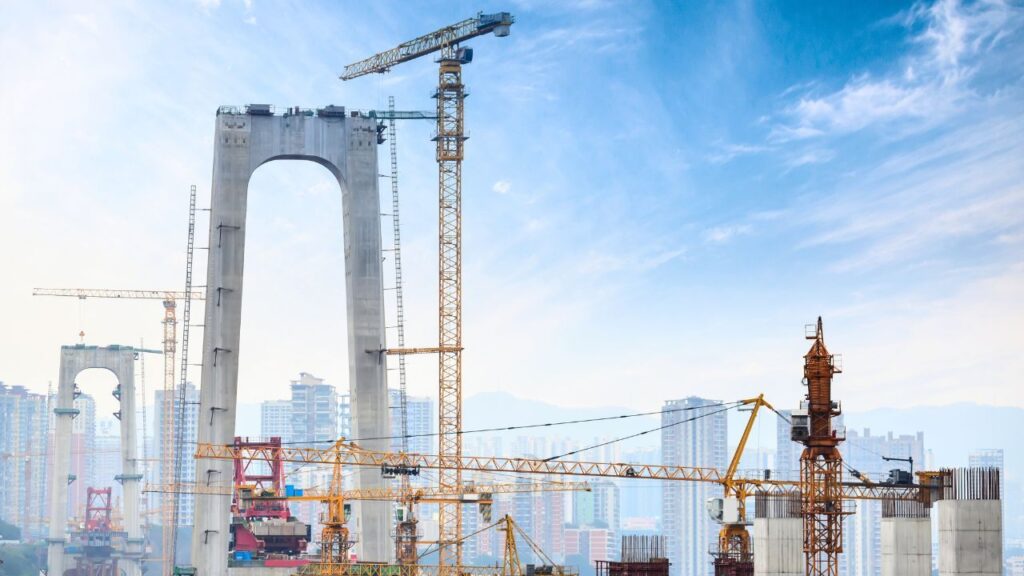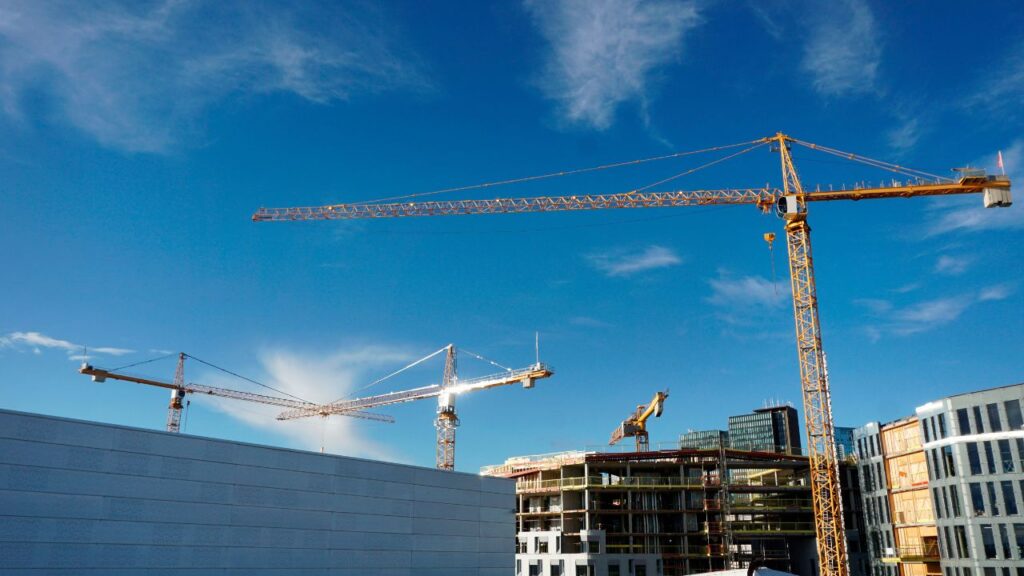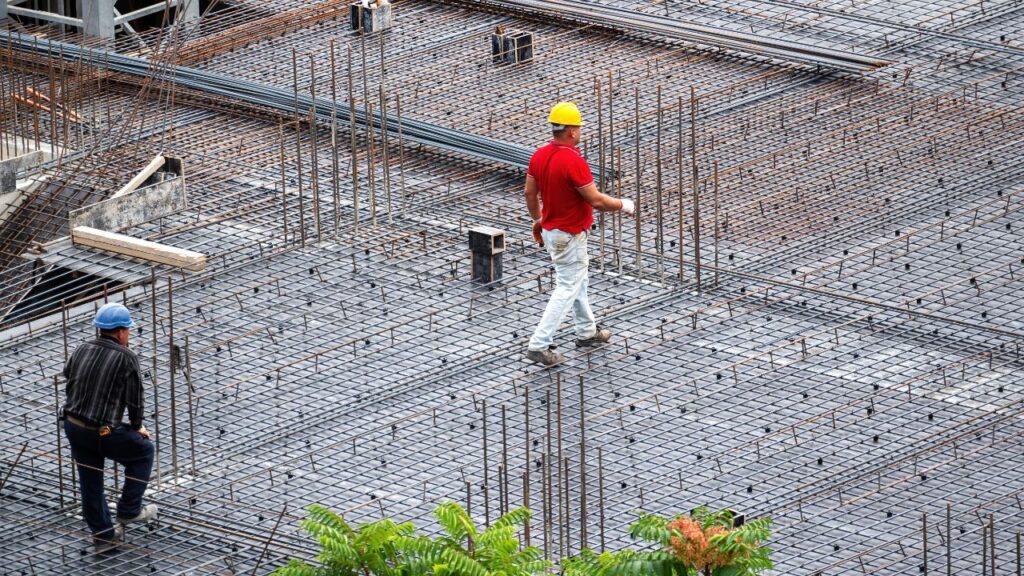A Wining Cost Estimate
That Helps You To Win More Construction Projects

As a professional in the construction industry, it is crucial to understand the process of estimating and bidding for projects. Accurate estimates are essential to ensure the project’s success and profitability.
The following table shows the critical steps in Understanding the Construction Estimating and Bidding Process:

Steps | Description |
|---|---|
Project Analysis | Assessing project scope, timelines, materials, and labor. |
Quantity takeoff | Measuring quantities of materials needed for the project. |
Cost estimation | Developing an accurate estimate of project costs. |
Bid submission | Submitting a competitive bid for the project. |
In addition to these critical steps, effective communication with stakeholders, including architects and clients, is necessary for a successful bid.
To stay ahead of competitors in the industry, it is vital to stay up-to-date with current trends, technologies and constantly improve estimating techniques.
Don’t miss out on potential opportunities by underestimating or overbidding projects. Invest in accurate estimating methods to improve profitability and success rates.
Investing time and effort into understanding construction estimating and bidding processes will lead to more efficient operations, better profitability, and client satisfaction.
Estimating construction costs is like predicting the weather – you might be right, but don’t be shocked if you end up with a storm of expenses.

To master the art of construction estimating with an eye for bidding projects, you need to perfect the essential elements involved in construction estimating. In this segment “Essential Elements for Construction Estimating”, we’ll cover the vital sub-sections that any construction estimator should be aware of, including Types of Construction Projects and Estimating Methods, Blueprints and Specs Analysis, Material Takeoff and Quantity Survey, and finally, Labor and Equipment Cost Analysis.
For any construction project, it is essential to have an accurate estimate to avoid costly mistakes and delays. This requires an understanding of the types of construction projects and estimating methods available.
A Table can be used to organize the various Types of Construction Projects and Estimating Methods. Each column can include information on the project type, method of estimation, and any unique considerations.
Some examples of construction project types include Residential, Commercial, Industrial, and Infrastructure. Estimating methods may include Square Footage Calculation, Assembly and Systems Estimation or Unit Price Estimation. For example, when estimating a commercial building, different cost-per-square-foot rates may be applied for the office space versus retail space.
When considering more technical projects like industrial facilities or infrastructure projects such as roads or bridges, additional factors like materials costs and safety regulations may be involved.
To ensure accurate estimates for all possible scenarios,
Analyzing blueprints and specs is like trying to unravel a maze, except the prize at the end is a budget instead of a piece of cheese.
Identifying the Technical Specifications and Drawing Analysis
Various important construction elements require consideration to prepare an accurate estimate. One such element is identifying technical specifications and analyzing the drawing. In today’s world, accuracy is everything as it helps avoid unnecessary expenses. To ensure that the estimate made is precise, it is pivotal to identify technical specifications of building maintenance systems and analyze the drawings.
To represent better, we have created a table outlining factors required for accurate estimating:
Factors | Explanation |
|---|---|
Building Maintenance Systems | Identify different systems |
Quantity | Determining how much material is required |
Quality | Material requisites for building longevity |
Drawings | Analyze drawings carefully |

Identifying building maintenance systems, determining quantities, material quality requisites, and analyzing drawings are vital aspects for preparing an accurate estimate. However, identifying unique details like geographical location also contributes significantly towards cost estimation.
Pro Tip: Enlist all relevant information before starting the estimation process to eliminate any possibility of misestimation or errors in construction costs.
If only estimating the amount of chocolate needed for a recipe was as easy and precise as material takeoff and quantity survey.
To ensure accurate cost estimation, it is critical to perform a comprehensive analysis of Material Takeoff and Quantity Survey data. This involves determining the types and quantities of materials needed for a job. Within this procedure, various elements are evaluated, including labor costs, type of material, projected timeframe, and overall complexity of the project. By adhering to this protocol, accurate estimates can be provided to clients. In the following table, vital components that should be incorporated into Material Takeoff and Quantity Survey analyses are highlighted:
Component | Description |
|---|---|
Material | Type of material required for the job |
Quantity | Amount of material necessary for project completion |
Labor Cost | Total cost associated with hiring workers |
Completion | Projected time frame involved in completing each task |
Complexity | Degree of difficulty concerning each element |
Overall Cost | Total budget required to complete the project |
It’s essential to conduct thorough Material Takeoff evaluations as they allow contractors to assess their construction needs accurately. Accidents arising from oversights in estimating projects are all too common. Realizing this can enable clients to maintain appropriate control over prices while ensuring that their projects adhere to safety measures and deadlines. One suggestion that has proven effective time and again is preparing standardized documentation templates beforehand. Using these templates prevents mistakes caused by manual errors or variations introduced by team members working on different documents. Another practice is closely examining plans prepared by clients’ architects or engineers before revising them based on your requirements or presenting revisions if necessary. It will prevent issues resulting from last-minute additions or omissions, saving valuable company resources over time. Calculating labor and equipment costs is like a game of Jenga, one misplaced bid and the whole project comes tumbling down.

Semantically analyzing the expenses on labor and equipment is a crucial element in construction estimating. A detailed analysis using proper tools and skills can help in cost estimation accurately.
Characteristics | Labor Cost | Equipment Cost |
|---|---|---|
Cost for unit time | $50/hr | $100/hr |
Number of units required for a task | 8 labors/tank foundation | 1 bulldozer/day |
Distinctive features play a vital role in determining the accurate budget for the project. Accurate allocation of funds according to the required tasks can lead to efficiency in getting the desired outcomes.
Unique specifications of projects vary widely, which results in increasing differences in expenditures. Diligent analysis of expenses on primary activities allows timely intervention at an early stage, simplifying expenditure management without causing financial stress.
Once I worked with a team that estimated significant cost savings could be achieved by cutting down workforce size to shift from manual labor tasks to automated heavy machinery utilization. The end result was a significant reduction in projected costs, and optimum resource utilization had been achieved.
We like our bidding process like our coffee – strong, competitive, and with no room for cream.
To streamline the Bidding Process in Construction with Preparing Bid Documents, Bid Submission and Clarifications, Bid Evaluations, and Awarding as solution. These sub-sections help to understand the bidding phase from start to end. They cover everything from gathering bid information to determining the winning bidder.
To put together a competitive bid, construction companies must create an array of essential documents. These documents must accurately reflect the project specifications and requirements to ensure that the proposal is both viable and credible.
One key element of preparing a bid document is constructing a detailed scope of work that outlines all aspects of the project. This may include descriptions of materials to be used, deadlines, and quality expectations. The construction company should also consider outlining potential challenges, such as site access issues or environmental concerns.
Another important aspect is including financial details such as itemized pricing lists and projected profit margins. The bid document should also provide details about payment terms, budget constraints, and change orders.
When preparing bid documents, it’s crucial to pay close attention to detail. Accuracy can be reinforced through rigorous proofreading by multiple individuals who possess expert knowledge in the industry.
Pro Tip: Be sure to confirm that all necessary documentation has been provided before submission to improve the likelihood of success in the bidding process.
Submitting a construction bid is like throwing your hat in the ring, except the ring is full of other hats and also a lot of money.
Maximize your flooring construction business’s potential with our competitive financing options

The success of a construction project depends on various project management processes, and bidding is no exception. Bid submission and clarifications are crucial facets of the bidding process in construction.
Bid Submission and Clarifications
Key Activities |
– Preparing the bid documents |
– Reviewing the project requirements |
– Submitting the bid documents on time |
– Providing necessary clarifications |

To win a construction bid, contractors must submit compelling bids on time while following all specifications. Bid submissions require thorough preparation, careful review of project requirements, timely delivery while providing any requested clarifications.
Pro Tip: Always double-check bid documents before submission to ensure accuracy and completeness.
May the bid be ever in your favor, but remember – winning the contract is just the beginning of the construction Hunger Games.
In the domain of Construction Procurement, the process of assessing bids and awarding contracts to the most fitting bidder is a critically essential aspect that helps in ensuring successful project delivery. To accomplish the same, Bid Evaluations and Contract Awarding processes are performed, which involve systematically reviewing proposals and tender submissions against relevant criteria to ensure compliance with requirements while fulfilling specific performance-based specifications.
To dive deeper into this topic, let’s have a look at an illustrative table that covers various dimensions of Bid Evaluations and Awards.
Dimensions | Description | Importance |
|---|---|---|
Technical Factors | Technical Feasibility & Performance | High |
Commercial Terms | Price Quotes & Payment Schedule | High |
Risk Management | Identifying & Mitigating Risks | Moderate |
Previous Experience | Past Project Delivery Record | Moderate |
It’s notable that apart from technical and commercial factors, risk management and past performance play an important role in deciding upon a winning bid.
As bid evaluations are typically undertaken manually by subject matter experts, it often becomes time-consuming and costs heavily on personnel resources. Thus proactive engagement with bidders throughout the tendering process can help improve communication, increase transparency while maintaining accountability.
For instance, a reputed construction company XYZ following its stringent evaluation process was evaluating bids for constructing new premises. After comprehensive analysis and scrutiny against set criteria; the selection committee finally chose ABC Company due to their experience in similar projects where they followed best safety practices resulting in timely delivery while staying within budget limits.
Bidding may not be rocket science, but estimating accurately could be the difference between landing the project or crashing and burning.

To improve your construction estimating and bidding process, you need to adopt best practices by embracing technology in estimating and communication, managing data accurately, collaborating effectively with stakeholders, and continuously improving the process through learning. These are the sub-sections that will be explained in detail.
For the modern construction companies, adopting technology in estimating projects can provide a competitive advantage. With streamlined processes and efficiency, companies can enhance their workflows while minimizing human error.
Technology to Adopt | Advantages |
|---|---|
Cloud-Based Programs | Saves Time and Money |
Drones | Increases Accuracy |
Virtual Reality | Enhances Visualization |
Incorporating technologies like drones can help contractors obtain precise measurements while reducing the risk of error. Cloud-based programs offer reliable real-time data accessible from any location, promoting efficient teamwork within the company. Moreover, with virtual reality visualization tools, clients get a 3D view of the finished project before construction begins, saving time and resources.
To succeed in today’s competitive market architects and their professional design teams must embrace the latest technological advancements in estimating. By implementing these tools – cloud-based programs for remote access to data; drones to enhance accuracy; VR visualization software– contractors cement their proficiency at meeting industry standards.
Don’t fall behind your competitors! By incorporating technology-driven estimating practices into your workflow plan today!
Remember, communicating with stakeholders is key – because if you don’t, you might end up building a house of cards instead of a house of bricks.
Effective Collaboration with Key Players
In construction projects, precise communication and collaboration with all stakeholders is vital. This includes building owners, contractors, subcontractors, architects, designers, and consultants. Accurate information exchange during the pre-construction phase aids in preventing delays, discrepancies and unforeseen costs.
Collaboration in Construction Estimating
Collaboration among stakeholders during the bid preparation process is critical for pragmatic estimation and winning proposals. Hold a pre-bid meeting to ensure everyone understands deadlines, expectations and scope of work. Provide transparent pricing documentation to promote trust between stakeholders.
Avoiding Misunderstandings through Communication
Clarity in communication can prevent misunderstandings between parties during any project stage; this enhances decision-making. Utilizing standardized contract terms and creating clear project documentation can save trouble or even lawsuits that may arise due to lack of understanding.
History Shows Communication and Stakeholder Collaboration Can Save Projects
Large capital construction projects across continents have failed due to poor stakeholder collaboration and miscommunication during prioritization, costing and scheduling activities. Research shows that maintaining closed-loop feedback mechanisms within organizations leads to information accuracy which increases cost certainty percentages.
Keeping your data up-to-date is key to accurate estimating, because apparently time machines don’t exist yet.

The success of a construction project heavily relies on accurate and up-to-date project information. From labor costs to material expenses, all the data needs to be documented and filed securely for future reference. Here are some best practices for managing and maintaining project data.
Data Management | What is it? | Why is it important? |
Document control | The process of organizing, storing and accessing all necessary documents in one central location. | To save time, reduce errors, mitigate risks and uphold compliance |
Budget & expense tracking | The continuous updating of budgetary information to ensure that the allocated funds are being utilized efficiently. | To prevent overspending, make data-driven decisions, enhance performance evaluation |
Daily reporting | A system that logs daily activities, progress updates, RFI’s etc., that occur during a project. | To keep track of progress made against targets, stay informed about the current project’s state and mitigate disputes between teams/vendors. |
Recording day-to-day activities utilizing data management systems can help identify potential issues before they become problematic. For instance – if any worker reports a safety issue or potential delays in delivery schedules – these issues can be timely mitigated resulting in increased efficiency.
Proper management of data is vital for reducing risk exposure during construction projects. Failure to manage your information effectively could potentially result in cost overruns or even missed deadlines. Make use of modern tools and software while training the team to track and record information with complete transparency.

Before you begin any construction project, adhere to these data management practices to ensure success, transparency and cost optimization. Don’t jeopardize your next project by failing to manage and maintain accurate and up-to-date project information.
Learning never stops, especially in construction estimating and bidding where you’re always one miscalculation away from bankruptcy.
Continuous improvement is key to effective estimating and bidding in construction projects. Regular evaluations of past performance, identifying areas of weakness and implementing corrective measures, as well as staying informed on industry advancements through attending workshops and seminars, are essential to staying competitive. Additionally, utilizing advanced estimation software can enhance accuracy and streamline processes. It is necessary to adapt and learn continuously to succeed in the constantly evolving construction industry.
Efficient project management and successful estimating require continuous learning and development. Contractors can benefit from analyzing their past performance by feedback from previous jobs and communicating with clients about any concerns or issues that arose during the project execution. Identifying areas for improvement enables contractors to implement corrective measures that ultimately result in a competitive edge over other bidders.
Staying current with technological advancements through attending workshops, seminars, conferences or online courses allows for continuous personal growth within one’s technical abilities. Utilizing advanced estimation software increases productivity by streamlining administrative tasks such as producing estimates, proposals and invoices while avoiding errors caused by manual data entry.
Neglecting continuous learning will lead to being outpaced by competitors who incorporate best practices into their operations. By developing one’s skills while keeping up with industry developments leaders position themselves for success while reducing the risk of being left behind.
Construction estimating is the process of calculating the approximate cost of a construction project based on various factors, such as materials, labor, equipment, and other expenses.
Construction bidding is the process of submitting a proposal to undertake a construction project at a specified cost based on the estimate of the construction cost.
Factors that affect construction estimating and bidding include materials, labor, equipment, overhead and profit, project duration, project complexity, and geographic location.
To ensure accurate construction estimating, it is important to have a clear and detailed project plan, access to up-to-date cost data, utilize accurate estimating software, and review the estimate with experts in the field.
The benefits of construction estimating and bidding include increased efficiency, cost savings, improved project management, better communication with stakeholders, enhanced profitability, and improved client satisfaction.
To improve your construction estimating and bidding skills, you can take courses, attend seminars, read industry publications, and seek advice and guidance from experienced professionals in the field.
Here I am going to share some steps to get your construction cost estimate report.
You can send us your plan on info@estimatorflorida.com
Before starting your project, we send you a quote for your service. That quote will have detailed information about your project. Here you will get information about the size, difficulty, complexity and bid date when determining pricing.
We do construction cost estimating and prepare a detailed report for your project. At last you finalize the report and finish the project.
561-530-2845
info@estimatorflorida.com
Address
5245 Wiles Rd Apt 3-102 St. Pete Beach, FL 33073 United States
561-530-2845
info@estimatorflorida.com
Address
5245 Wiles Rd Apt 3-102 St. Pete Beach, FL 33073 United States
All copyright © Reserved | Designed By V Marketing Media | Disclaimer
IMPORTANT: Make sure the email and cell phone number you enter are correct. We will email and text you a link to get started.
By clicking “I Agree” above you give Estimate Florida Consultin express written consent to deliver or cause to be delivered calls and messages to you by email, telephone, pre-recorded message, autodialer, and text. Message and data rates may apply. You are able to opt-out at any time. You can text STOP to cancel future text messages.